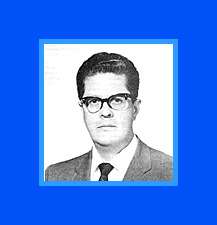Guillermo González Camarena
Guillermo González Camarena (17 February 1917 – 18 April 1965) was a Mexican electrical engineer who was the inventor of a color-wheel type of color television, and who also introduced color television to the world.
Guillermo González Camarena | |
|---|---|
 Guillermo González Camarena | |
| Born | 17 February 1917 Guadalajara, Jalisco, Mexico |
| Died | 18 April 1965 (aged 48) Puebla, Mexico |
| Nationality | Mexican |
| Education | National Polytechnic Institute |
| Occupation | Engineer |
| Spouse(s) | María Antonieta Becerra Acosta |
| Engineering career | |
| Discipline | Electrical engineer |
| Projects | Chromoscopic adapter for television equipment |

Early life
González Camarena was born in Guadalajara to Arturo González and Sara Camarena.
His older brother Jorge González Camarena was a prominent painter, muralist and sculptor. Primeros Años de Vida
Cuando Guillermo era un niño, le encantaba hacer juguetes que se movían con electricidad en su sótano. A los 9 años, inventó una alarma sísmica, a los 12 años, inventó un transmisor amateur y a los 17 años, ya había construido su propio televisor utilizando piezas de repuesto de radio. El inventó muchas cosas y esto lo llevó a ser un ingeniero. (Innovadores de América)
Familia
Sus padres son Sara Camarena y Arturo González. Su hermano mayor era Jorge González Camarena y fue pintor, muralista y escultor. Su esposa se llamaba Marie Antoinette Becerra Acosta. Estuvieron casados de 1951 a 1965. Tenían dos hijos llamados Guillermo González Camarena Becerra y Arturo González Becerra. Guillermo murió en el 15 de septiembre de 2018. Arturo González Becerra sigue vivo.
Las citaciones
Innovadores de América. “Guillermo González Camarena.” https://www.innovadoresdeamerica.org/en/profiles/guillermo-gonzalez-camarena/ Innovadores de América. Published April 20, 2018. Accessed November 2019.
Antena San Luis. “Guillermo González Camarena, una de las grandes mentes contemporáneas que dejó un gran legado en México.” http://antenasanluis.mx/guillermo-gonzalez-camarena-una-las-grandes-mentes-contemporaneas-dejo-gran-legado-mexico/. Antena San Luis. Published 2017. Accessed November 2019.
Protocolo Foreign Affairs & Lifestyle. “Murió hijo del inventor de la TV a color Guillermo González Camarena Becerra Acosta.” https://www.protocolo.com.mx/mexico/murio-hijo-del-inventor-de-la-tv-a-color-guillermo-gonzalez-camarena-becerra-acosta/. Protocolo Foreign Affairs & Lifestyle. Published September 18, 2018. Accessed November 2019.
Career and inventions
González Camarena invented the "Chromoscopic Adapter for Television Equipment", an early color television transmission system. He was only 17. A U.S. patent application (2,296,019) states, "My invention relates to the transmission and reception of colored pictures or images by wire or wireless..." The invention was designed to be easy to adapt to black-and-white television equipment. González Camarena applied for this patent August 14, 1941, and obtained the patent September 15, 1942. He also filed for additional patents for color television systems in 1960 and 1962. He sold his first set in 1954 for about $1,450.
On August 31, 1946, González Camarena sent his first color transmission from his lab in the offices of The Mexican League of Radio Experiments, at Lucerna St. #1, in Mexico City. The video signal was transmitted at a frequency of 115 MHz. and the audio in the 40-meter band.
He obtained authorization to make the first publicly announced color broadcast in Mexico, on February 8, 1963, Paraíso Infantil, on Mexico City's XHGC-TV, a station that he established in 1952. By that time, the government had adopted NTSC as the television color system.
Death
He died in a car accident in Puebla on April 18, 1965, returning from inspecting a television transmitter in Las Lajas, Veracruz.
Legacy
A field-sequential color television system similar to his Tricolor system was used in NASA's Voyager mission in 1979, to take pictures and video of Jupiter.[1]
There was a Mexican science research and technology group created La Fundación Guillermo González Camarena or The Guillermo González Camarena Foundation in 1995 that was beneficial to creative and talented inventors in Mexico.
At the same time, the IPN began construction on the Centro de Propiedad Intelectual "Guillermo González Camarena" (Guillermo González Camarena Intellectual Property Center).
- Gallery




References
-
- Enrique Krauze - Guillermo González-Camarena Jr. "50 años de la televisión mexicana" (50th anniversary of Mexican T.V.) - Year 1999 Mexican T.V. Documentary produced by Editorial Clío & Televisa, broadcast in 2000)